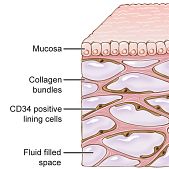
Greek researcher in the team that discovered a major organ in the human body
Researchers at the New York University School of Medicine and NYU Langone Health Center have found a new organ so to speak, that can be one of the largest in the body based on its structure and distribution. This part of the body is called the interstitium and is an already known space in the body that comprises of fluid filled spaces that spans all over the body.
The study titled, “Structure and Distribution of an Unrecognized Interstitium in Human Tissues” was published this week in the latest issue of the journal Scientific Reports.
Dr. Petros Benias, co-lead author of the study, an assistant professor at the Donald and Barbara Zucker School of Medicine at Hofstra/Northwell Health said that this study opens up new avenues of research in diagnostics as well as in deeper understanding of disease pathology, inflammation and cancer. New personalized treatments via the interstitium could also be on the cards he said.
Interstitium or interstitial fluid has been known to doctors for some time now but this new study provides a fresh insight into the role that this plays in the human body and scientists are now calling it a new organ. Dr. Neil Theise, Professor of pathology at NYU Langone Health in New York, who was a co-senior author of the study said they thought that this was an “interesting tissue” initially. But when they looked deeper into it, they found that it corroborated with the idea of an organ viz. “it has a unitary structure or that it’s a tissue with a unitary structure, or it’s a tissue with a unitary function.” Interstitium has both, he explained. “This structure is the same wherever you look at it, and so are the functions that we’re starting to elucidate,” he said. Skin is the largest organ of the body making up 16 percent of the body. This interstitium seems to be larger than that at around 20 percent or around 10 litres in a young adult human he added.
For this study the team looked at the interstitium using a powerful microscope using confocal laser endomicroscopy wherein the tissue samples are bathed in a fluorescent liquid to delineate their structure in minute details. They obtained tissue samples from human bile ducts of 13 patients undergoing pancreatic surgeries at Mount Sinai Beth Israel in New York. On microscopy they found that spaces were seen where fluid can collect. These spaces are not lymphatic channels but their fluids drain into the lymph nodes.
According to Theise, when they see tissues under the microscope, they are dead and dehydrated and thus this space is not visible. In living tissues the spaces are clearly seen. “Once you see it, you can’t unsee it, he said.
Next steps in this direction would be to get a clearer understanding of these tissues and the spaces and understand how they actually work in the body. The study throws light on how the interstitium could be helping the spread of the cancer cells from one part of the body to another. Theise explained that it is already known that cancer first spreads to the outermost part of the organ or the skin before it starts to spread. It could be the interstitium that has to be breached by the cancer cells in order for them to spread he said. The researchers write that it this fluid could be helping the spread of the cancer, a sampling of this fluid may help in detection of the cancer cells before they have spread to the other organs. Several other diseases can also be potentially diagnosed using the analysis of the interstitial fluid said Theise.









